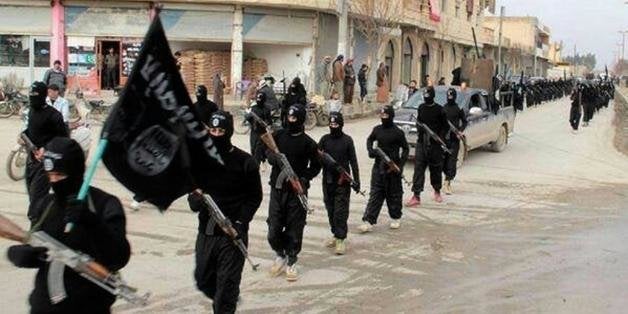
Last week, New York police arrested three Brooklyn men, immigrants from post-Soviet states Uzbekistan and Kazakhstan, and charged them with aiding the Islamic State (ISIL). One of the men's online postings questioned whether it is "possible to commit ourselves as dedicated martyrs while here [in the U.S.]... to shoot Obama and then get shot ourselves."
ISIL uses a rigorous propaganda method to recruit fighters like them, and they have attracted 20,000 foreign combatants so far. Russia has the largest Muslim population in the West, and, together with its newly independent Islamic neighbors, like Uzbekistan and Kazakhstan, has supplied a significant jihadist force. Reuters reported recently that the flow of European fighters has decreased due to tighter travel restrictions, while now most foreign fighters are coming from Asia. A recent report from president of Kurdistan Massoud Barzani revealed that ISIL has been recruiting retired Soviet army officers.
This is not an entirely new development: Uzbek radio announced last year that up to 3,500 Uzbeks joined Islamists in Iraq and Syria, and in 2013, 1,700 Chechens formed their own military divisions in ISIL. Further, Russian is the lingua franca on thousands of online jihadist promotional sites directed to the multi-national, multi-ethnic population across post-Soviet territories, including music videos that use traditional nasheeds, song-poems, to sway impressionable young hearts. Recruiters in Russia, and especially in Caucasus, also visit market places to talk to merchants and frequent visitors to woo them.
And clearly, some are wooed, including youth. Last month, A Kazakh boy became the star of online ISIL propaganda when he shot two kneeling men accused of spying for Russia. Two months earlier, dressed in camouflage and a matching bandanna, Kalashnikov rifle in hands, he was filmed before a cohort of armed children, and when an interviewer asked him what he will do in the future, inshallah (Allah's will), the boy, looking straight at his interviewer, utters: "I will be the one who slaughters you, O kuffar, I will be a mujahidid [Islamic fighter], inshallah." Robbing them of their childhood, the Islamist extremists turn children like him into ideological killing machines.
The jihadists also exploit children's joy of play. For example, in one video, soft voices, simple melodies and engaging rhythms accompany Chechen-born Abu Omar al-Shishani, an ISIL leader, as he swims with two-or-three-year-old kids. He later is shown teaching them to use AK47s. Another red-bearded Muslim al-Shishani, visiting a training center for young mujahedeen, welcomes a stream of six- to eight-year-old boys, parading with automatics in their hands (the video and audio were removed, only photograph remains online).
Not protected and seen as disposable, children also become victims of jihadists. The U. N. Committee on the Rights of the Child released a report on January 22 about ISIL's treatment of children, including how they have sold and executed, burned, beheaded, crucified and buried them alive. They have also sold girls as sex slaves and used mentally disabled kids as suicie bombers. The mass destruction of minorities' children coincides with making their own into brainwashed monsters who play soccer with severed heads, are curious observers of tortured adults nailed to crosses and kneel before executioners. The global madness of jihad defies humanity.
Of course, it's not just children who ISIL recruits. The men join as fighters, and women fulfill the fighters' needs, bury children, and also die as shahids (suicide-killers). Sometimes entire families are involved, such as the 150-member Kazakh family that migrated from its homeland to join ISIS in Syria in 2013 Speaking native Kazakh mixed with Russian and Arabic, the family consists of 60 armed men, dozens of women and teens and at least 20 small children.
Despite this targeted recruitment and the thousands who are joining ISIL from the region, the world's, particularly the U.S.', main focus regarding Russia is whether or not Putin will attack Ukraine. ISIL's atrocities and growing appetite must also be a priority for the united global community, but it's not. Currently, for example, the Center for Strategic Counterterrorism Communications, established under the direction of the White House to "coordinate, orient, and inform government-wide foreign communication activities against terrorism," has an outreach team that counters terrorist propaganda in Arabic, Urdu, Somali, Punjabi and English, but not Russian. Among those attending the global summit on extremism in Washington, D.C. in February was Aleksandr Bortnikov, the head of Russia's Federal Security Service, but as a last-minute surprise participant, suggesting the U.S. was not eager to work with Russia on this crucial issue.
Last week, Bortnikov proposed to "cooperate with his American counterparts" in fighting ISIL. While there are tensions between Russia and the U.S., there still must be coordinated communication among data analysts, media producers, psychologists and secret services in these countries, and others, to exchange, share and collaborate their efforts. Decades ago, the evil of World War II was crushed by the unlikely alliance of the Soviet Union, Great Britain and the United States. The historical precedent can be an example to current leaders in Russia, the U.S., and elsewhere as they work to crush ISIL.